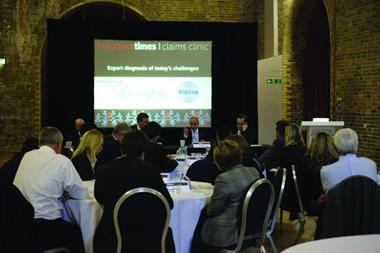A souped-up minor road accident system is finally hitting the road this month, promising a quicker process and a dramatic reduction in costs. But insurers remain nervous
Long-awaited reforms to the way minor road traffic accidents (RTAs) are handled by the courts ‘go live’ next week on 30 April. The new Ministry of Justice rules are designed to create a streamlined legal process for low-value RTAs (see box ‘How the new three-stage process works’). Its architects hope to slash costs from a not untypical £22,000 per case to £2,500.
The introduction of the new process has been bedevilled by delays, however, with the implementation date already pushed back twice. So how prepared is the industry for this major shake-up? Talking to insurers and suppliers, there is a palpable sense of nervousness about how the new system will work.
Testing times
SLS (part of Crawford) technical director Andrew Wylie says: “It’s like when the Woolf reforms were introduced; there was a lot of uncertainty. Insurers and claimant lawyers have had enough time to prepare for implementation, but we won’t know how effective that preparation has been until it has happened.”
The delays were triggered by concerns that insurers and suppliers would not be ready to use the new internet portal through which all claims are meant to be funnelled. A straw poll of insurers and suppliers carried out a fortnight ago showed that many had only just received the password needed to train staff on the new portal.
But despite earlier troubles, most sounded relaxed. While 30 April is the launch date for the new system, the number of claims coming through will be relatively low at first, building up as time goes on. Therefore, there will be opportunities to stagger the training process.
The website itself appears to hold few terrors. Halliwells’ head of delegated authority litigation Jonathan Watts says the site appears to be “straightforward and simple”. Portal provider IDSL’s executive director Fraser Fundell adds: “There will be teething problems … but we will make sure that they are resolved.”
Likely to be more challenging are the tighter deadlines that insurers will have to abide by.
Loss adjuster Garwyn’s director of legal services John Bundy says: “From day one, claimants will have to be right on the ball with giving information. You can’t allow them two or three days. It’s far, far more streamlined.”
To ready themselves for the new process, many firms have already cut down the initial period for turning around claims to 15-20 days.
The new process also means that firms must change how they handle claims, with a much greater emphasis on the front end of the process.
Brit Insurance motor claims manager Paul Adderson sees this as an opportunity to cut costs. “By making decisions at an earlier stage in the life of the claim, there will be a small cost reduction. We see it as an opportunity to polish up our processes by improving the speed of settlement and the delivery of services to individual claimants – it’s win, win. If we can keep the volume of claims the same, it will result in a small reduction in costs.”
Nevertheless, any transition tends to create headaches. While the new and theoretically more streamlined system will operate from 30 April, insurers will still be dealing with claims being handled under the old and more cumbersome regime – a recipe for bottlenecks. To free up capacity, some are understood to have been outsourcing pre-30 April work.
Don’t miss a trick
A longer-term concern is the heightened risk for fraud under the new system. Under the MoJ’s rules, a case can be booted off the fast track if there is any suspicion that it is fraudulent.
But the opportunity to pay smaller costs by settling early gives insurers a clear commercial incentive to achieve quick resolution rather than pursue fraud investigations, which offer no guarantee of success.
Weightmans partner Chris Ball says: “The risk is that cases will be missed that we might have caught if we had a little longer, because you might have the chance to talk to a witness. Once liability is gone, there’s a risk that further research won’t be admitted and the chance to tackle that fraudulent claim has gone.”
Adderson counters that a lot of fraud is detected “right at the front end of the process”, adding: “We are going to be given more information at the outset about the claimant. That should enable us to ask more detailed questions. Information about claimants has been drip fed; we might have found out about a passenger over two years after a claim was first raised. Under the new process, everybody has to be named and identified.”
But, he insists, Brit will not be bullied by deadlines. “We realise that we have to make a quick decision, but if there’s any suggestion of fraud, rather than being forced into the wrong decision we would ensure that it comes out of the process.”
Wylie agrees, saying: ”If a claim has to fall outside the process, it will have to fall outside.”
But claimants’ lawyers, whose costs are the target of the shake-up, are unlikely to take the changes lying down. Watts says it is “inevitable” that there will be “satellite litigation” to challenge the new process. One group of personal injury lawyers has already threatened to bring a judicial review of the reforms. “There will be lots of lawyers looking at the rules and looking at ways of circumventing it,” he says.
But Garwyn’s Bundy believes that it will be hard to achieve a significant enough volume of cases to overwhelm the new system. And, he insists, the new process will deliver benefits all round. “With the increasing legal costs where liability is not really contested and genuine claimants having to wait for years, it needed to be done.” IT
How the new three-stage process works
The new streamlined process applies to road traffic accidents (RTAs) occurring on or after 6 April 2010 and comes into force on 30 April. It applies to low-value claims for RTA personal injuries for between £1,000 and £10,000. Claimants’ solicitors will be paid fixed costs.
Stage one
The claimant solicitor completes the claim notification form and sends it to the insurer, who may admit or deny liability. The insurer has 15 working days in which to respond, with this deadline extended to 30 days for Motor Insurers' Bureau claims under the uninsured drivers’ agreement. If the insurer concedes liability, the case proceeds to stage two. Fixed costs of £400 are payable at this point.
Stage two
If the insurer admits liability, the claimant obtains a medical report, for which there is no fixed timetable. Within 15 working days of the report being confirmed as factually correct, the claimant solicitor completes a stage two settlement pack, which is submitted electronically to the insurer to consider. The insurer has 15 working days in which to accept the offer or make a counter offer to settle the claim. If neither happens, the matter falls out of the process. If an insurer submits a counter offer, there is 20 days available for further negotiation. Where agreement cannot be reached on a counter offer within this period, the matter will proceed to a court hearing.
Fixed recoverable costs of £800 will apply to all claims taken forward under this process from the beginning to the end of the process, with a 12.5% success fee where a conditional fee agreement is in place.
Stage three
If the parties cannot agree a settlement, the matter proceeds to a court hearing. The settlement pack setting out both parties’ final offer is lodged in a sealed envelope, only to be seen after the judge has made his decision, which will generally be determined via a paper hearing. If the claimant is successful, the insurer will pay further costs of £250 for paper hearings and £500 for oral hearings, plus a success fee of 100%. Defendants’ costs for stage three will be identical.
Hosted by comedian and actor Tom Allen, 34 Gold, 23 Silver and 22 Bronze awards were handed out across an amazing 34 categories recognising brilliance and innovation right across the breadth of UK general insurance.














































No comments yet